
Jul . 27, 2024 07:43 Back to list
Understanding the Applications and Uses of Hydroxyethyl Cellulose in Various Industries
What is Hydroxyethyl Cellulose Used For?
Hydroxyethyl cellulose (HEC) is a non-ionic, water-soluble polymer derived from cellulose, which is a natural polymer found in the cell walls of plants. This compound is widely used across various industries due to its unique properties, which include thickening, binding, and film-forming capabilities. HEC is characterized by its ability to form clear, viscous solutions when dissolved in water, making it a valuable ingredient in numerous applications.
What is Hydroxyethyl Cellulose Used For?
In the construction industry, hydroxyethyl cellulose plays a crucial role as an additive in cement-based materials, such as mortars and plasters. By improving the workability and consistency of these mixtures, HEC ensures that they can be easily manipulated and applied. The addition of hydroxyethyl cellulose also enhances the water retention capacity of the mixtures, preventing premature drying and cracking. This is particularly important in outdoor applications, where environmental conditions can impact the setting and curing of materials.
what is hydroxyethyl cellulose used for

Another significant application of HEC is in the pharmaceutical industry, where it serves as a binder and thickening agent in various formulations, including tablets and gels. Hydroxyethyl cellulose can help stabilize drug formulations, ensuring that active ingredients remain evenly distributed throughout the product. Its biocompatibility and non-toxic nature make it an ideal choice for use in pharmaceutical applications, particularly for products intended for prolonged skin contact. Furthermore, HEC is often used in ophthalmic preparations, where it acts as a lubricant and helps retain moisture in eye drops.
In the food industry, hydroxyethyl cellulose is utilized as a food additive, primarily as a thickening agent or stabilizer. It can enhance the texture and consistency of various food products, including sauces, dressings, and ice creams. HEC can also serve as a fat replacer in low-fat foods, providing a creamy mouthfeel without adding calories. This makes it a popular choice among food manufacturers who are looking to create healthier options without sacrificing quality.
Additionally, hydroxyethyl cellulose is gaining traction in the field of paints and coatings. As a rheology modifier, it improves the flow and application properties of water-based paints, ensuring a smooth and even finish. HEC helps to control the viscosity of the paint, allowing for easy application while preventing sedimentation of pigments and other components.
In conclusion, hydroxyethyl cellulose is a versatile and essential ingredient found in multiple industries, including cosmetics, construction, pharmaceuticals, food, and paints. Its ability to act as a thickener, stabilizer, and binder, combined with its eco-friendly nature, makes it a preferred choice for formulators aiming to create effective and innovative products. As consumer preferences continue to shift towards natural and sustainable ingredients, the demand for hydroxyethyl cellulose is likely to grow, reinforcing its significance in diverse applications.
-
Versatile Hpmc Uses in Different Industries
NewsJun.19,2025
-
Redispersible Powder's Role in Enhancing Durability of Construction Products
NewsJun.19,2025
-
Hydroxyethyl Cellulose Applications Driving Green Industrial Processes
NewsJun.19,2025
-
Exploring Different Redispersible Polymer Powder
NewsJun.19,2025
-
Choosing the Right Mortar Bonding Agent
NewsJun.19,2025
-
Applications and Significance of China Hpmc in Modern Industries
NewsJun.19,2025







